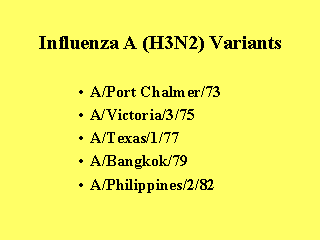 |
H3N2 has mutated many times since its emergence in 1968. For example, between
1973 and 1982, five antigenic variants have emerged, at the intervals of two to
three years. It continues to mutate. In 1997, a new H3N2 variant, A/Sidney/5/97,
emerged and caused many cases of influenza in the United States during the
winter 1997-98. The most recent antigenic variant is A/New Caledonia/20/99
(H1N1); over two-thirds of the H1N1 strains isolated in the winter 1999-2000
were antigenically different from the previous H1N1 strain. Thus, the Caledonia
strain was selected for inclusion in the influenza vaccine for the 2000-2001
season. |
